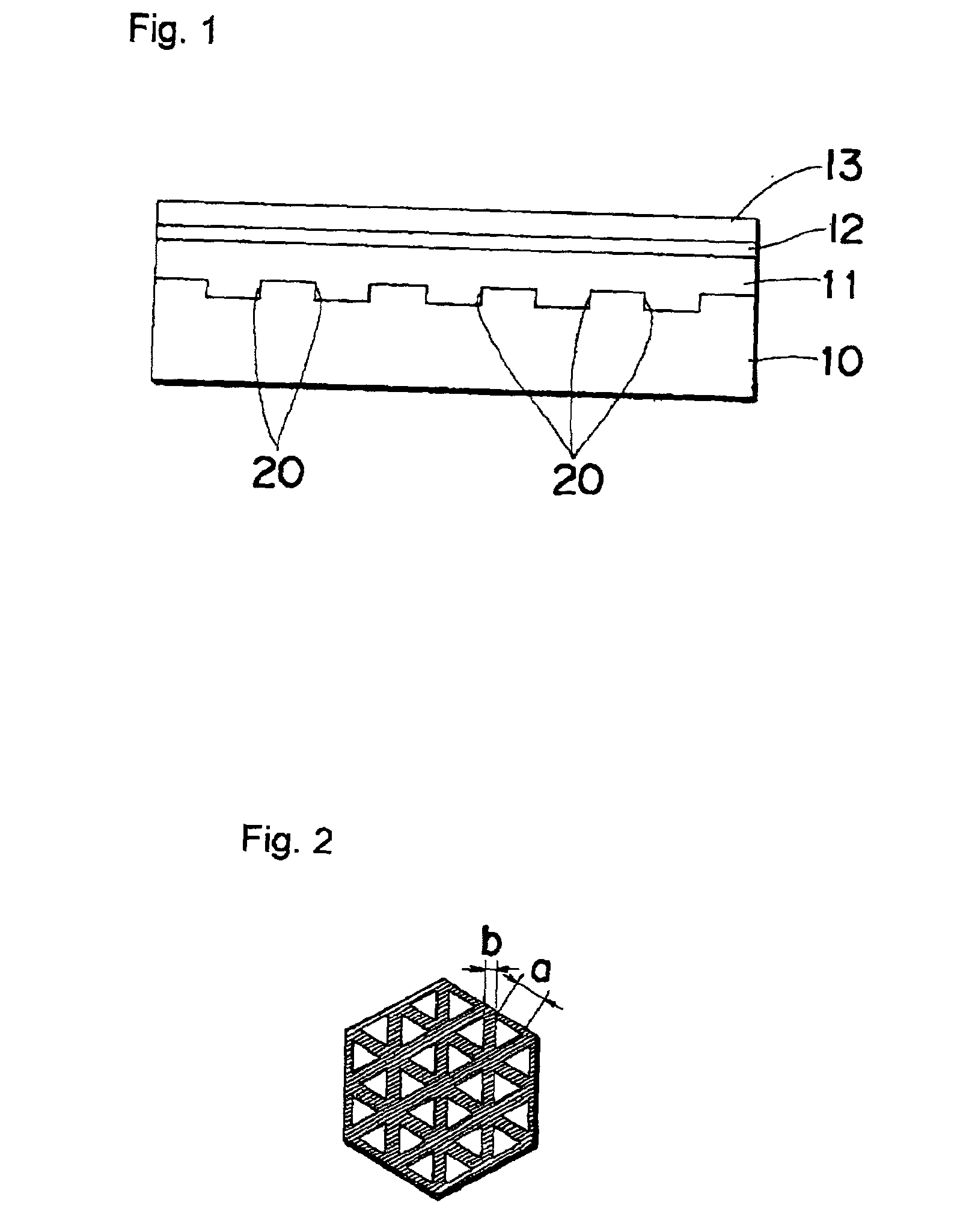Semiconductor light emitting device
a technology of semiconductors and light emitting devices, which is applied in the direction of solid-state devices, basic electric elements, transportation and packaging, etc., can solve the problems of reducing the external quantum efficiency of the device, attenuating the light, and unable to effectively emit to the outside,
- Summary
- Abstract
- Description
- Claims
- Application Information
AI Technical Summary
Benefits of technology
Problems solved by technology
Method used
Image
Examples
example 2
[0111] A sapphire substrate, of which a C plane (0001) is used as the main surface, having the orientation flat in an A plane (11-20) is used as the substrate.
[0112] A process in the substrate and layering of an n-type semiconductor layer to a p-type semiconductor layer are carried out in the same manner as in first example.
[0113] Next, a p-type semiconductor layer made of Mg doped GaN, an active layer and a portion of the n-type semiconductor layer are etched in order to form an n electrode so that the n-type semiconductor layer made of Si doped GaN is exposed.
[0114] Next, a photomask having a pattern wherein equilateral triangles having a side of 5 .mu.m, as shown in FIG. 16, are most densely filled per unit area is utilized so that a light transmitting p electrode made of Ni / Au is formed on almost the entirety of the surface of the p-type semiconductor layer.
[0115] Furthermore, a p-side pad electrode made of Au is formed at a position opposite to the exposed surface of the n-type...
example 3
[0118] A sapphire substrate, of which a C plane (0001) is used as the main surface, having the orientation flat in an A plane (11-20) is used as the substrate.
[0119] A process of the substrate and layering of an n-type semiconductor layer to a p-type semiconductor layer are carried out in the same manner as in first example.
[0120] Next, starting from Mg doped GaN, the p-type semiconductor layer, an active layer and a portion of the n-type semiconductor layer are etched in order to form an n electrode so that the Si doped GaN layer is exposed.
[0121] Next, a photomask of a square pattern is utilized so as to form a p electrode 104 made of Rh on almost the entirety of the surface of the p-type semiconductor layer. The shape of the openings is square, of which side is 7.7 .mu.m. The interval of the openings is 6.3 .mu.m. The aperture ratio of the opening is about 30%.
[0122] Furthermore, a p-side pad electrode made of Pt / Au is formed at a position opposite to the exposed surface of the n...
example 4
[0125] In the light emitting device of third example, p electrode is formed in a stripe form, as shown in FIGS. 14C. By adopting such a stripe electrode structure, a current supplied from a p-side pad electrode to semiconductor layer is made uniform within the surface to increase the efficiency of the light emission.
[0126] The stripes of the first electrode are created as openings that expose semiconductor layer and therefore, the length of the edge of the electrode can be significantly increased and as a result, the efficiency of the light emission is increased. At this time, it is preferable to achieve L / S.gtoreq.0.024 .mu.m / .mu.m.sup.2 wherein the value of S is gained by adding the total area Sa of openings 5 corresponding to the plurality of stripes, which exposes semiconductor layer, and area Sb of the electrode portion that does not expose semiconductor layer, and the value of L is the total sum of the length of the circumferences of openings 5.
PUM
 Login to View More
Login to View More Abstract
Description
Claims
Application Information
 Login to View More
Login to View More - R&D
- Intellectual Property
- Life Sciences
- Materials
- Tech Scout
- Unparalleled Data Quality
- Higher Quality Content
- 60% Fewer Hallucinations
Browse by: Latest US Patents, China's latest patents, Technical Efficacy Thesaurus, Application Domain, Technology Topic, Popular Technical Reports.
© 2025 PatSnap. All rights reserved.Legal|Privacy policy|Modern Slavery Act Transparency Statement|Sitemap|About US| Contact US: help@patsnap.com



